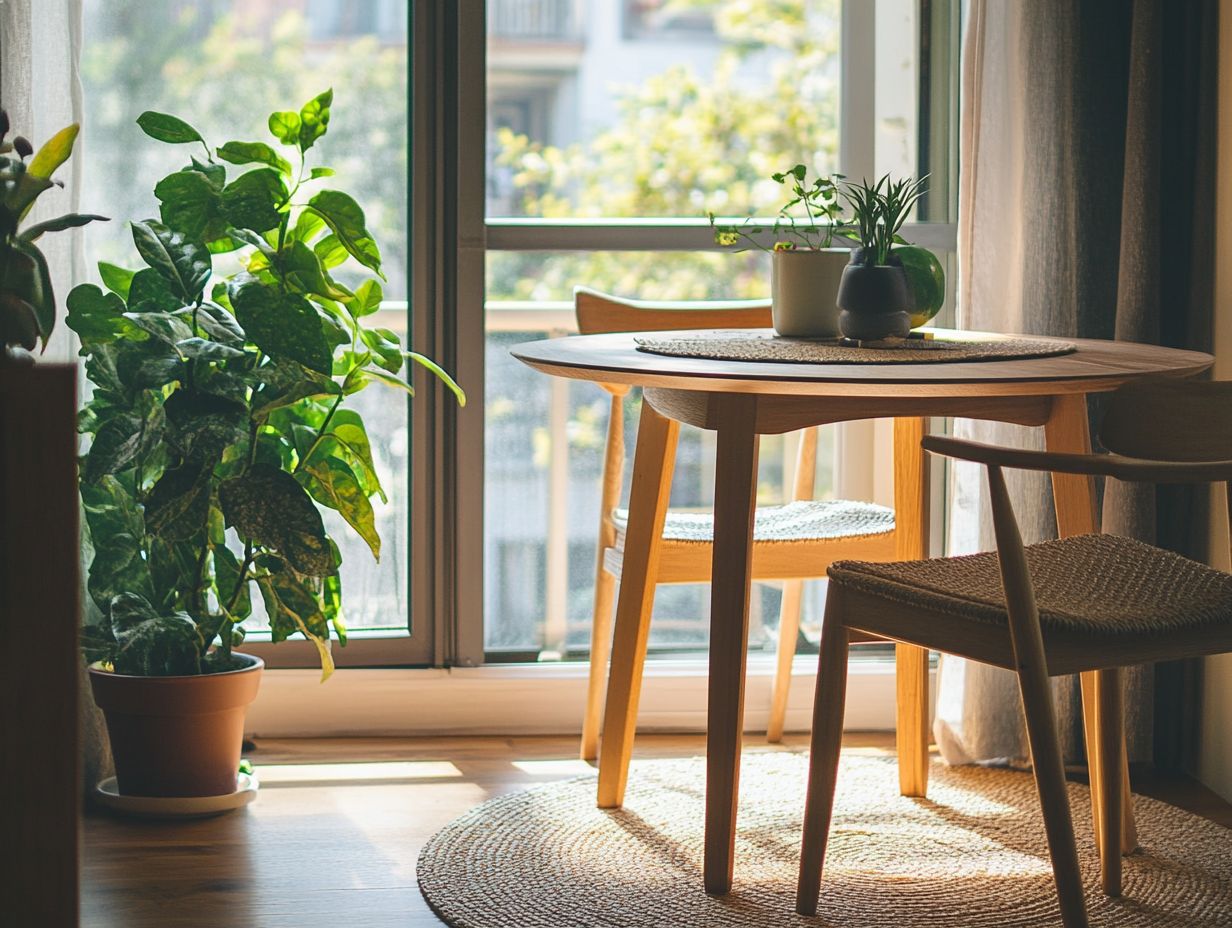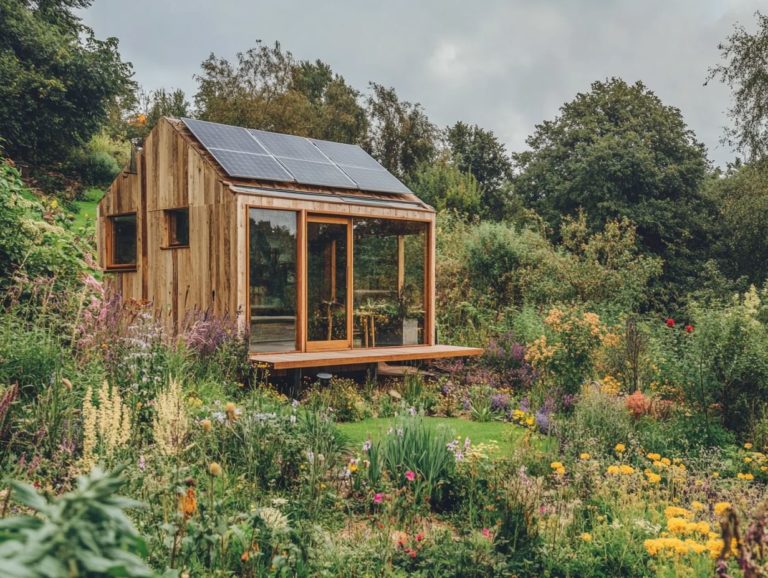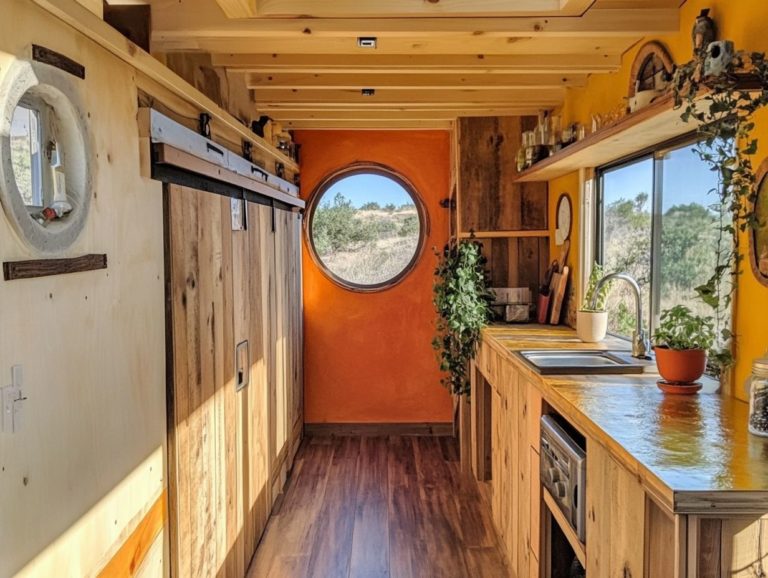Eco-Friendly Furniture Options for Tiny Living
In your quest for sustainable living, eco-friendly furniture offers a remarkable opportunity, particularly if you re embracing the tiny home lifestyle.
This article delves into innovative furniture solutions that not only maximize your space but also minimize your environmental impact. From multi-functional and modular designs to sustainable materials and vintage treasures, you ll discover options that make eco-conscious living both stylish and practical.
Join the journey as we explore the best ways to integrate these eco-friendly choices into your tiny living space. We ll provide insights on materials, potential cost savings, and the best places to find those perfect pieces.
Contents
- Key Takeaways:
- 1. Multi-Functional Furniture Pieces
- 2. Sustainable Materials
- 3. Vintage or Upcycled Furniture
- 4. Modular Furniture for Space Optimization
- 5. Furniture Made from Recycled Materials
- 6. Minimalistic Designs
- 7. Energy-Efficient Appliances
- 8. Furniture with Built-In Storage
- 9. Natural and Non-Toxic Finishes
- 10. Furniture Rental or Borrowing Options
- How Can Eco-Friendly Furniture Benefit Tiny Living?
- What Are the Most Sustainable Materials for Furniture?
- How Can One Incorporate Eco-Friendly Furniture into Their Tiny Home?
- What Are the Long-Term Cost Savings of Choosing Eco-Friendly Furniture?
- What Are the Challenges of Finding Eco-Friendly Furniture for Tiny Living?
- What Are the Best Places to Find Eco-Friendly Furniture for Tiny Living?
- Frequently Asked Questions
- What are some eco-friendly furniture options for tiny living?
- How can I make my tiny living space more environmentally friendly?
- Are there affordable eco-friendly furniture options for tiny living?
- Can I still have stylish furniture in my tiny living space while being environmentally conscious?
- How can I ensure that the furniture I purchase is truly eco-friendly?
- Are there health benefits to using eco-friendly furniture in my tiny living space?
Key Takeaways:

- Choose multi-functional furniture pieces to optimize space in tiny living; they are ideal for small-space solutions.
- Consider sustainable materials like bamboo or reclaimed wood for eco-friendly furniture choices.
- Explore vintage or upcycled furniture options for a unique and environmentally friendly touch in tiny living spaces.
1. Multi-Functional Furniture Pieces
In the world of sustainable living, multi-functional furniture pieces are essential for creating a conscious home environment. They help you maintain style and comfort while maximizing your space.
These innovative designs resonate with ethical practices and foster a healthier indoor atmosphere through the use of sustainable materials and thoughtful designs.
If you re working with limited square footage, multi-functional furniture becomes a game-changer. Partnering with sustainable brands like West Elm and IKEA, which prioritize eco-conscious practices, allows you to curate inviting spaces that reflect your values.
Consider options like convertible tables that transition from dining to workspace or ottomans that double as stylish storage solutions. These pieces spark creativity in how you arrange your home.
Embracing multi-functional furniture can also lead to a decluttered environment. A tidy space significantly boosts your mental well-being, creating a serene living area.
By selecting thoughtfully designed furniture that serves multiple purposes, you can transform even the coziest of spaces into a functional and stylish sanctuary.
2. Sustainable Materials
Sustainable materials are at the heart of eco-friendly furniture design. They play a vital role in reducing the greenhouse emissions of your living spaces while protecting your health.
Incorporating elements like reclaimed wood minimizes waste and infuses your home with character and history. This creates a more inviting atmosphere.
Recycled fabrics allow you to avoid the need for new resources while promoting creative designs that tell a unique story. Choosing nontoxic materials helps keep harmful chemicals at bay, ensuring a healthier environment for you and your family.
Your choices reflect a commitment to ethical practices in furniture production. Prioritizing the well-being of our planet and the integrity of craftsmanship leads to a responsible and fulfilling lifestyle.
3. Vintage or Upcycled Furniture
Embracing upcycled furniture is not just a stylish choice; it s a statement in sustainable living and ethical practices within the furniture industry.
By opting for these unique pieces, you support artisan craftsmanship and contribute to a circular economy designed to minimize waste. Selecting items with a history, like a mid-century modern chair or a reclaimed wood dining table, brings distinctive character and charm to your space.
Brands such as West Elm and Anthropologie often feature collections that emphasize fair trade practices. Marketplaces like Chairish and Etsy present a treasure trove of one-of-a-kind upcycled designs.
Each of these options showcases a commitment to quality and sustainability. They are the perfect choice for the conscientious consumer you aspire to be.
Are you ready to transform your living space? Start your eco-friendly journey today!
4. Modular Furniture for Space Optimization
Customize your space effortlessly with modular furniture that adapts to your needs! Modular furniture presents innovative solutions for optimizing your space, particularly if you re managing the challenges of tiny houses or compact apartments.
The adaptability of modular furniture helps you create versatile living environments. It’s effortless to transform a single room for various purposes whether it s working, unwinding, or entertaining.
For example, brands like IKEA and Resource Furniture offer modular sofas that can be reconfigured into different shapes or sizes. Companies like Muji provide stackable shelves that fit perfectly into smaller spaces.
These pieces enhance functionality and champion sustainable living with their timeless designs and durability. They re an excellent choice for those who are environmentally conscious and eager to maximize their space without sacrificing style.
5. Furniture Made from Recycled Materials
Furniture crafted from recycled materials marks a remarkable stride toward sustainability. Enjoy stylish and functional options that resonate with your values while minimizing your environmental impact.
These innovative pieces often feature materials such as reclaimed wood, recycled metal, and even repurposed plastic. This illustrates how waste can be transformed into exquisite design.
By selecting this type of furniture, you endorse eco-friendly practices and play a crucial role in reducing landfill waste while conserving precious natural resources.
Brands like West Elm and Joybird are at the forefront of this movement. They showcase collections that highlight responsibly sourced materials and timeless designs.
Their commitment to sustainability goes beyond just production; it includes initiatives that engage communities and foster a deeper understanding of the environmental consequences of consumption.
6. Minimalistic Designs

Minimalistic designs in furniture not only resonate with modern aesthetics but also foster a healthier living environment. They reduce clutter and prioritize quality over quantity, echoing the values of The Good Trade.
This approach naturally aligns with eco-friendly and sustainable choices. It promotes the use of durable materials that withstand the test of time instead of disposable items that contribute to waste.
Brands like Muji and IKEA, particularly their more sustainable lines, focus on crafting simple, functional pieces from responsibly sourced materials. This underscores the significance of sustainability.
By choosing minimalistic furniture, you create a serene atmosphere that enhances your well-being. With fewer distractions and less visual noise, you ll experience improved mental clarity and relaxation in your living spaces.
7. Energy-Efficient Appliances
Incorporating energy-efficient appliances into your home is vital for embracing eco-friendly living. By doing so, you significantly reduce energy consumption and minimize your environmental impact.
These modern appliances harness advanced technology to perform tasks while using less power. This ultimately saves you money on utility bills.
When you choose products with high energy efficiency ratings, particularly those carrying the ENERGY STAR certification, you enhance your living space and make a meaningful contribution to sustainable practices.
Renowned brands like Bosch, Whirlpool, and LG lead the way in producing environmentally friendly options. They blend efficiency with stylish design, making it easier to create a conscious home.
Don t wait to embrace eco-friendly living upgrade to energy-efficient appliances today! Transitioning to these appliances helps pave the way for a greener future and encourages a lifestyle that values sustainability and responsibility.
8. Furniture with Built-In Storage
Furniture with built-in storage is truly an ingenious solution for maximizing space in your smaller home while adhering to eco-friendly principles. It does this through the use of sustainable materials and showcases artisan craftsmanship.
Imagine incorporating elements like ottomans with hidden compartments, coffee tables that cleverly open for extra storage, or beds equipped with drawers underneath. This approach allows you to minimize clutter while maintaining style.
Such versatile pieces not only elevate the aesthetic of your space but also provide functional advantages that are especially valuable in urban living environments. Choosing designs that utilize reclaimed wood or bamboo significantly reduces your environmental footprint.
Ultimately, these innovative furniture solutions champion both practicality and sustainability. They are perfect for anyone who values eco-friendly living and seeks customized luxury.
9. Natural and Non-Toxic Finishes
Choosing furniture with natural and non-toxic finishes is crucial for cultivating a healthy living environment. This choice minimizes your exposure to harmful chemicals often found in conventional furniture.
These finishes also safeguard your indoor air quality. By selecting materials like paints with fewer harmful chemicals, water-based stains, and sustainably sourced woods, you’ll be making a real difference in reducing your carbon footprint.
Brands like VivaTerra and West Elm prioritize eco-friendly practices. They utilize finishes that incorporate organic and recycled materials. Natural oils and waxes enhance the beauty of wood while extending its lifespan, making such furniture a wise investment in sustainable living.
By opting for these products, you contribute to a healthier planet while enjoying stunning, durable home decor.
10. Furniture Rental or Borrowing Options
Furniture rental or borrowing options present a smart choice to traditional ownership. They grant you access to high-quality, eco-friendly furniture without the strings attached to a purchase.
This approach saves you money and helps the planet! It also significantly minimizes waste, encouraging a more mindful lifestyle.
Many platforms are now dedicated to sustainability. They offer a diverse array of selections crafted from recycled or responsibly sourced materials. By opting to rent, you actively participate in a circular economy, where products are reused and repurposed rather than relegated to landfills.
These services often come with flexible rental periods and convenient delivery options. This makes it easy to refresh your space as your tastes or needs change. This blend of convenience and commitment to eco-friendly practices makes furniture rental an enticing choice for anyone eager to decorate with intention.
How Can Eco-Friendly Furniture Benefit Tiny Living?
Eco-friendly furniture brings a wealth of advantages for tiny living. It presents innovative solutions that maximize functionality while keeping style and comfort intact essential elements for a conscious home environment.
By prioritizing sustainable materials and designs, you can embrace a minimalist lifestyle with versatile pieces that cater to multiple needs. For example, a compact sofa bed doubles as a chic seating area by day and a cozy sleeping space by night.
Brands like West Elm and Floyd offer modular shelving units. These adapt seamlessly as your storage needs evolve, making them ideal for ever-changing tiny spaces.
The smart design of foldable coffee tables and expandable dining sets not only conserves space but also showcases your commitment to environmental responsibility. For more tips on maximizing your tiny home’s potential, check out how to choose the right tiny home furniture. Transform functional living into a truly artful experience.
What Are the Most Sustainable Materials for Furniture?

The most sustainable materials for your furniture include reclaimed wood, recycled fabrics, and other eco-friendly options that not only reduce waste but also enhance your living environment.
Choosing reclaimed wood sourced from old barns or buildings gives new life to materials that might otherwise go to waste. This choice helps decrease the demand for new timber, contributing to forest preservation.
Opting for recycled fabrics like those made from post-consumer textiles or plastic bottles lets you enjoy stylish yet sturdy pieces that minimize waste while supporting a circular economy.
Bamboo, known for its rapid growth and renewability, serves as an excellent alternative to traditional hardwoods, offering durability and strength with a significantly lower environmental footprint.
By selecting these sustainable materials, you re not just furnishing your space; you re making a powerful statement for ethical practices within the industry and championing artisans who prioritize environmental mindfulness.
How Can One Incorporate Eco-Friendly Furniture into Their Tiny Home?
Incorporating eco-friendly furniture into your tiny home is both a practical choice and a stylish endeavor. This thoughtful approach enhances your well-being and the aesthetic appeal of your compact environment.
When selecting furniture pieces, prioritize multifunctional items that serve more than one purpose. For example, a sofa that effortlessly converts into a bed saves space and serves dual functions seamlessly. Incorporating sustainable design practices for tiny houses by using materials like reclaimed wood or bamboo ensures your furniture is environmentally friendly.
By focusing on these elements, you can create an inviting and eco-conscious haven that reflects your values while catering to your lifestyle needs.
What Are the Long-Term Cost Savings of Choosing Eco-Friendly Furniture?
Choosing eco-friendly furniture is a savvy move, leading to long-term cost savings through reduced energy consumption, lower maintenance costs, and enhanced durability. It s a wise investment for a healthier living environment.
Selecting pieces made from sustainably sourced materials elevates your home’s aesthetic while minimizing your ecological footprint. For instance, furniture crafted from reclaimed wood often offers remarkable durability, decreasing the need for constant replacements. Additionally, exploring smart design solutions for tiny house living can enhance functionality in compact spaces.
Energy-efficient designs that embrace sustainable production practices can significantly reduce your utility bills over time. Additionally, eco-friendly materials can improve indoor air quality, positively impacting your health and overall well-being.
Ultimately, investing in sustainable options benefits your wallet while promoting a lifestyle that champions environmental stewardship.
What Are the Challenges of Finding Eco-Friendly Furniture for Tiny Living?
Finding eco-friendly furniture for tiny living can be an adventure. You might encounter challenges like limited options, higher costs, and the need to carefully consider sustainable materials and practices.
Navigating the world of sustainable design often calls for a dash of creativity and resourcefulness. You may feel overwhelmed by the myriad choices and price ranges, especially in smaller living spaces where every inch truly matters. To make the best use of your space, consider how to choose the right furniture for tiny homes.
However, there are effective ways to streamline this process. By prioritizing multifunctional pieces like a sofa that transforms into a bed or a coffee table with hidden storage you can maximize your space without compromising your environmental values.
Exploring local artisans who work with reclaimed materials not only gives you unique furnishings but also supports your community and helps reduce carbon footprints.
What Are the Best Places to Find Eco-Friendly Furniture for Tiny Living?
You can find eco-friendly furniture for your tiny living space at specialized retailers, online platforms, and artisan markets. These places focus on sustainable materials and ethical craftsmanship.
Explore a wide range of unique pieces made from renewable resources and recycled materials. Brands like West Elm and IKEA prioritize sustainability by using responsibly sourced wood and eco-friendly finishes.
Online marketplaces like Etsy showcase artisans who craft custom-made furniture from reclaimed wood and non-toxic paints. This way, you support small businesses while reducing your environmental impact.
Local artisan markets feature regional craftsmen who value ethical labor practices. Each purchase helps create a more sustainable economy.
Frequently Asked Questions
What are some eco-friendly furniture options for tiny living?

Some eco-friendly furniture options include bamboo furniture, upcycled pieces, and items made from sustainable materials like reclaimed wood or recycled plastic.
How can I make my tiny living space more environmentally friendly?
Choose furniture made from sustainable materials. Use energy-efficient appliances and add natural elements like plants to your decor.
Are there affordable eco-friendly furniture options for tiny living?
Yes! Consider DIY projects with recycled materials, shopping for secondhand furniture at thrift stores or online, and exploring companies that offer budget-friendly, sustainable options.
Can I still have stylish furniture in my tiny living space while being environmentally conscious?
Absolutely! Many stylish options are available, including minimalist designs, multi-functional pieces, and furniture with a modern or rustic look, all made from sustainable materials.
How can I ensure that the furniture I purchase is truly eco-friendly?
Check for certifications like FSC (Forest Stewardship Council) and review the materials used in production. Research the company’s sustainability practices and commitment to environmental responsibility.
Are there health benefits to using eco-friendly furniture in my tiny living space?
Yes, eco-friendly furniture can improve indoor air quality. It often uses non-toxic materials and finishes, reducing harmful chemicals in your home.






